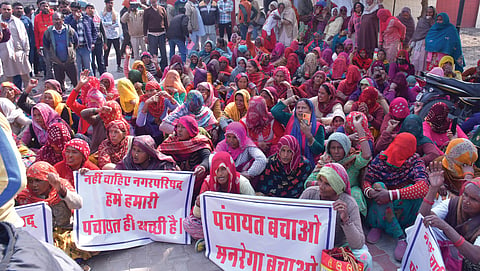

The crowd gathers every morning, banners in hand, their voices echoing through the streets of Hanumangarh in Rajasthan. Their demand is simple: restore their villages to the rural status they once held. The people of Satipura and 2 Knj, two of the six villages incorporated into the Hanumangarh municipal council on January 10, 2025, are protesting almost daily against the state government’s circular. For them, becoming “urban” is not a privilege but a crisis.
“We do not know how we will survive anymore,” says Jasram, a resident of Satipura. He and his wife have worked as daily-wage labourers under the Mahatma Gandhi National Rural Employment Guarantee Act (MGNREGA) for 15 years. The scheme, which ensures 100 days of employment annually to rural households, has been their economic lifeline. But with the villages now designated as urban, MGNREGA will no longer apply, leaving over 3,100 families in the two villages without a guaranteed source of income. “Gram panchayats allocate significant funds to MGNREGA, making it the backbone of rural employment,” says Anshuman Karol, lead for governance and climate action at Delhi-based non-profit Participatory Research in Asia (PRIA). He says residents in villages sit for protest the moment they realise that they will no longer be beneficiaries to government schemes for rural areas. While Rajasthan is one of the few states in the country with an urban employment initiative—Muk- hyamantri Shahri Rozgar Guarantee Yojana—it does not offer the same guarantee as MGNREGA.
“MGNREGA is a legal right, whereas the other is merely a scheme,” says Rajendran Narayanan, professor of economics at Azim Premji University in Bengaluru.
The concerns go beyond employment. Most village-dwellers depend on farming, and urban classification puts their agricultural land at risk of being repurposed for residential development. The fear is that livelihoods will be systematically eroded, forcing people into uncertain, low-paying jobs in towns and cities.
Hanumangarh is not an isolated case. Similar protests have erupted across Rajasthan, including in Jodhpur, Rajsamand, Tonk, Jaisalmer, Baran and Udaipur. Media reports suggest that people in villages in at least seven more states have resisted urbanisation over the past five years.
Villages are transformed into urban areas for two reasons: either the rural population has exceeded a certain threshold, which varies from state to state, or the population of an urban area has surged, necessitating expansion. According to the Technical Group on Population Projections under the Union Ministry of Health and Family Welfare, India’s urban population is expanding faster than its rural counterpart. The urban population, which stood at 31.8 per cent in 2011, is projected to rise to 38.2 per cent by 2036.
Earlier, village-dwellers would get enticed with the idea that the price of their land would go up after becoming a part of a town or city. “But now, they are protesting as they know it seldom helps them,” says Chandrashekhar Pran, founder of the Teesri Sarkar Abhiyaan, a Ghaziabad-based non-profit working on strengthening Panchayati Raj institutions.
For instance, Muradi, a village in Uttarkashi district, Uttarakhand, was designated a town in 2018. Before this change, its residents were largely self-sufficient and unlike many villages in the state, it had not experienced depopulation. Six years on, many are considering migrating for the first time.
“The administration told us the urban status would improve our lives. But we soon realised we had been misled,” says Krishna Murari Ramola, a resident of Muradi. A year after the transition, when residents requested repairs to their irrigation canals, they were informed that the responsibility no longer lay with the urban administration. The shift from panchayat governance to municipal councils often distances residents from decision-making. While gram panchayats function at a hyperlocal level, municipal bodies govern larger areas where individual concerns get lost in bureaucracy.
Urban classification also imposes financial burdens. Residents need to pay property taxes, water and drainage fees and waste management levies. Selling agricultural land also becomes more complicated due to stricter planning regulations. “When rural areas fall under city jurisdiction, Town and Country Planning rules apply. These are far more rigid than village norms, making house construction and land use more difficult,” says Karol.
“Villages are run by elected representatives, while cities are managed by bureaucrats. Yet, state governments continue to absorb villages into urban areas, stripping them of autonomy,” says Pran.
Ideally, urban expansion should follow a master plan, but Karol notes that many cities lack such frameworks. “As a result, villages are absorbed into cities without structured development and they often become dumping grounds for urban waste,” he adds.
There are also instances where villages have been included in urban areas to for political gain. Pran recalls an instance in Uttar Pradesh where a Member of the Legislative Assembly merged multiple villages—spanning a 15 km radius—into a municipal council without consulting the people. Similarly, in Haryana, a politician dissolved more than a dozen panchayats and merged them into a municipal corporation to facilitate his son’s mayoral bid, says Devendra Surjewala, retired joint director, Haryana Development and Panchayat Department.
Surendra Thanvi, an advocate practising at the Jodhpur High Court, says Article 243Q(2) of the Indian Constitution mandates that an area must meet specific criteria—including population density, revenue sources and non-agricultural employment rates—before being designated a municipality. Rajasthan’s Panchayati Raj Act, 1994, and Rajasthan Municipality Act, 2009, also outline procedures for municipal formation and expansion, including a mandatory one-month public notification period for objections. “Yet, in many cases, local opinion is not even sought,” says Thanvi. In 2023, he helped the residents of Goluwala Sihagaan Gram Panchayat secure a court stay order against the state government’s attempt to urbanise their village. Now, the residents of Satipura and 2 Knj are contemplating a similar legal battle.
This was first published in the 1-15 March, 2025 print edition of Down To Earth